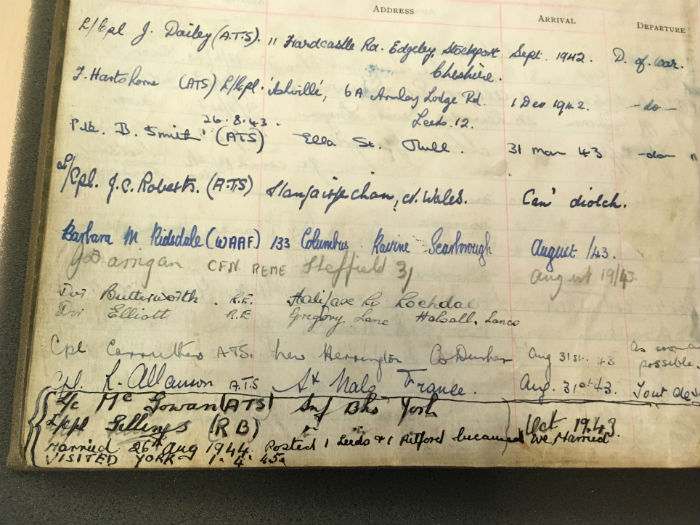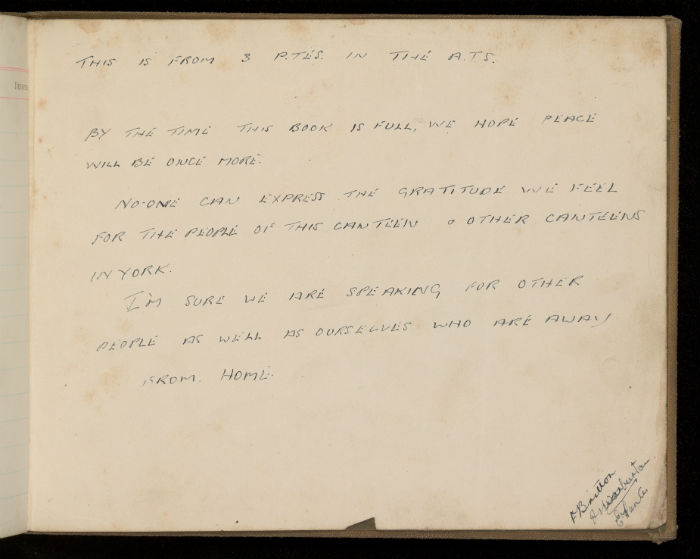Wartime love story discovered in the archives
Posted on 6 June 2019

Margaret and Sidney's entry in the forces canteen visitors' book.
n October 1943, Margaret McGowan and Sidney Gillings both visited a forces canteen housed in a Methodist chapel in York.
Margaret was a member of the Auxiliary Territorial Service (ATS), the women’s branch of the British army, and Sidney was with the Rifle Brigade – many battalions of which took part in the D-Day landings.
Civilians on the home front ran the canteen in an effort to provide some happiness and a social escape for forces stationed in the local area. They provided a library and billiard room and put on dances, film nights and a cricket team.
Margaret and Sidney entered their names and details in the canteen’s visitor book in pencil, one after the other. That evening turned out to be an important moment in both their lives as towards the end of the war, in April 1945, they returned to York to immortalise their time there together by inking over their names and adding that they had married on 26 August, 1944.
The record of Margaret and Sidney’s wartime romance was discovered during a project run by the Borthwick institute for Archives at the University of York to digitise the visitors’ book. What happened over the course of the rest of their married lives together remains a bit of a mystery.
Uncertain times
“Marriage rates rocketed during wartime,” explains Sally-Anne Shearn, one of the archivists on the project. “The insecurity of the future left people in need of a little hope and joy so they wanted to grab happiness where they could”.
“The fact that Sidney and Margaret returned to York to ink over their original entry suggests the City and the canteen were special to them as the place where they first met.”
The visitors’ book also provides a record of friendships forged or reinforced during the war between people passing through York at a turbulent and uncertain time. There are plenty of shared jokes and nicknames jotted in the margins.
“The book offers a snapshot into daily life in wartime,” says Lydia Dean, Joint-Archivist on the project. “It’s a lively alternative to the official records of men and women in service during the war. Some of my personal favourites are Pat, Micky and Jimmy who visited in November 1944 and call themselves the ‘Three Musketeers’ and the eight ‘little Naafi girls’ (Navy, Army and Air Force Institute) from Broad Oak Canvas City.”
Hope for peace
Visitors to the canteen came from all over the British Isles as well as France, America, Canada and South Africa.
“Many of the entries have added a nostalgic tribute to their home like ‘wild Wales’, ‘bonny Scotland’ or ‘good old Somerset,” adds Lydia. “And clearly not everyone enjoyed their time in York, with some putting their departure date down as ASAP!”
At the back of the book there is a poignant ‘hidden’ page with a note thanking the organisers of the canteen and expressing hope that the war would soon come to an end.

A transcript of the book has been created by volunteers and is now available online.
“We hope that people will recognise the names of their relatives and get in touch with more information about them”, says Sally-Anne. “We’d love to know more, particularly about Sidney and Margaret – whether they survived the war and if so what they did with their lives afterwards”.
